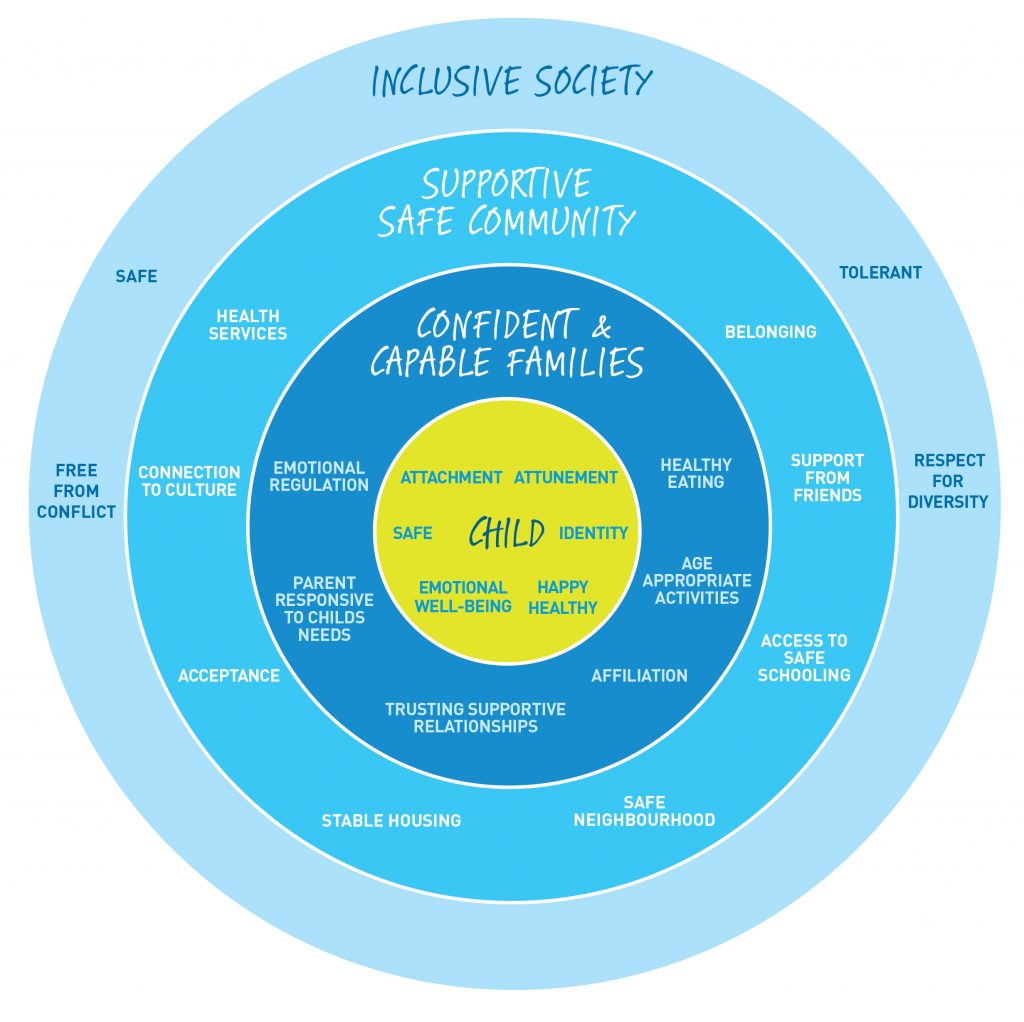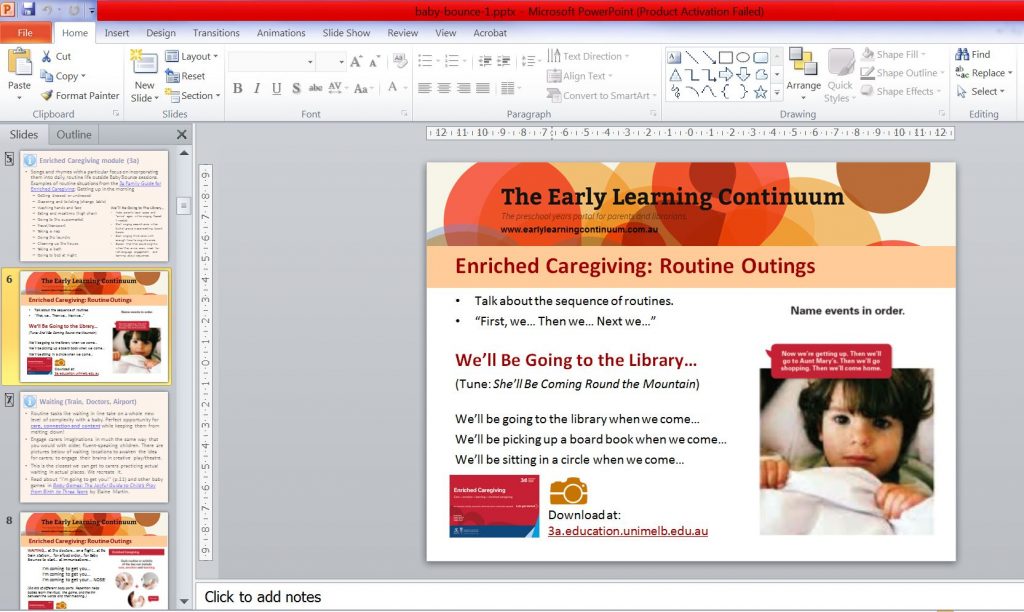This page contains a sample Baby Bounce or Babytime library session. I plan and develop the kinds of sessions that I would have liked, when I was a young mum attending library early years programs. Sessions that empowered me with tools to deal with the challenges of parenting. Sessions that modelled educational or behavioural strategies I could try at home. We don’t get schooled to be parents! Sessions that were validating, relevant and useful. Of course, we want to have fun! However, personal experience tells me a learning mum also wants inspiration. She wants to know how to continue that fun at home, during the many long hours spent alone and responsible for this child, whom she loves, but is not trained to educate or entertain.
In the formal library terminology, my sessions aim to specifically target the needs of new parents/carers and their babies on the learning continuum, supporting both parties’ next steps on the timeline of lifelong learning.
I draw on what I consider, for my purposes, to be the most helpful soundbites of all the early childhood methods and techniques I’ve studied. I weave in anything I’ve learned that helps to make sense of my experience as a mum of a young child—or indeed anything that makes sense of when I was a young child myself. I think about when learning had an impression on me—when it stuck. And then I think about what I wish I had known back then, that I know now. And I try to put those two things together: Information and skills that would have made life easier, better, more fun, more fulfilling, taught in a way that reflects all the best and most memorable learning moments that teachers/other people have facilitated for me.
The main message I want carers to take away is the one that most reassured me: you don’t have to do all this extra stuff to help baby grow up happy, or to learn. You just have to know the richness of what’s going on behind the scenes of all your routine interactions—and how to milk those mundane opportunities for every last scrap of emotional and developmental benefit. I want to sustain carers through the long mornings, up to nap time and a cup of tea.
You can look elsewhere on the site for how the choices in my sessions tie into the wider early childhood landscape, and as with any discipline, there is lively debate. I try to take all approaches, hypotheses, points of view into account in my work, and what looks like a patchwork quilt, in some ways, is stitched together by the thread of my experience. I filter the research for things that would have helped me, as a mother, feel better, and do better.

A Babytime Model
Quick Summary
- Session Introduction: Hello/Welcome Song
- 3a Enriched Caregiving: Songs and Games for Routine Daily Interactions
- 3a LearningGames™ and Play: Songs and Interactions with Objects and Concepts
- Dance/Movement/Whole-Bodied Engagement: Carers on Feet, Holding Baby
- A Bedtime Ritual for Every Day:
- 3a Conversational Reading: Choral Read with Dialogue Prompts/Modelling
- Lullaby: Nurturing Wellbeing Through Nightly Bedtime Music
- Session Close: Goodbye Song
- 3a Language Priority: Informal Playgroup with Activities for Free Play
Detailed Breakdown
1. Session Introduction: Hello/Welcome Song
- Same welcome song every week to tie into children’s need for routine and to signal the start of session.
- Same welcome song every week to give adults an opportunity to experience the motivating force of mastery at a task.
- Name tags important for working names into song (for both adults and kids), which aids relationship building between facilitator and group, and amongst participants.
- A gentle, seated activity.
- Set up space in a way that encourages families to sit in a circle, so everyone can see your manipulations of/modelling with dolly.
2. 3a Enriched Care-Giving:
Songs and Games for Routine Daily Interactions
- Songs and rhymes with a particular focus on incorporating them into daily, routine life outside Baby Bounce sessions. Examples of routine situations from the 3a Family Guide for Enriched Caregiving:
- Getting up in the morning
- Getting dressed or undressed
- Diapering and toileting (change table)
- Washing hands and face
- Eating and mealtime (high chair)
- Going to the supermarket
- Travel/transport
- Taking a nap
- Doing the laundry
- Cleaning up the house
- Taking a bath
- Going to bed at night
3. 3a LearningGames™ and Play:
Songs and Interactions with Objects and Concepts
- Songs and games based on 3a LearningGames™ and other developmentally supportive activities, like tummy time.
- A focus on integrating parent awareness of developmental needs/milestones, both physical and cognitive/social/emotional.
- Similar to Toddlertime activities, but with an even greater focus on hands-on parent engagement with baby (toddlers can begin to carry out more purposeful actions, and can therefore undertake more independent tasks).
- Take the evidence-based principles of the 3a LearningGames™, and adapt them to our typical library program toys and props, most of which are profiled for developmental and linguistic benefits on Playgroup WA’s Play Ideas page:
-
- Parachute
- Balls
- Egg shakers
- Instruments
- Cardboard tubes
- Bubbles
- Bean bags
- Ribbons / Scarves
- Foam blocks
- Tape rolls
- Feathers
- Puppets
- Mirrors
- Toys/rattles ideal for babies’ grip
- Giant scrunchies
- Etc
- Book resource recommendations:
- The Creative Curriculum LearningGames™ birth-12 months
- The Creative Curriculum LearningGames™ 12-24 months
- Moving to Learn by Robyn Crowe and Gill Connell
- Brain Games for Babies, Toddlers and Twos by Jackie Silberg
- Baby Games: The Joyful Guide to Child’s Play from Birth to Three Years by Elaine Martin
- Baby’s First Skills by Miriam Stoppard
- Make sure you critically match up your activity level with knowledge of the developmental milestones and pathways.
- Watch some videos of these props and toys in action with various ages.
4. Dance/Movement/Whole-Bodied Engagement:
Carers on Feet, Holding Baby
- An activity designed to encourage carers’ whole-bodied engagement, and bonding with baby.
- Establishes active, fun habits for both the adults’ and kids’ health.
- Works on carers’ and babies’ sense of rhythm awareness, balance, and much more.
- Opportunity to incorporate adult/pop songs and culturally traditional tunes/family anthems.
- Music Together® is the best model I have ever seen of group facilitation methods that establish safety and buy-in from parents in potentially intimidating and nerve-racking exercises like this. I cannot recommend their training highly enough for any early years practitioners working with both parents and children at the same time (even if you don’t do a lot of music). Even if this segment, for you as a facilitator, is more rhyme-based, rather than music based, or if you are more of a sports person than an arts person, the value in Music Together is how to facilitate multi-generational groups by leading with the body and behaviour.
5. A Bedtime Ritual for Every Day
-
3a Conversational Reading:
Choral Read with Dialogue Prompts/Modelling
- Once every family has a copy to share with their caregiver, facilitator to sit down with their “baby” doll and model.
- Signal the beginning of choral read by singing ‘Now It’s Time To Read a Book’ (set song) to the tune of ‘London Bridge Is Falling Down’:
- Now it’s time to read a book
- Read a book, read a book
- Now it’s time to read a book
- Let’s read a book together
- Facilitator to give examples of conversational opportunities from page to page, and encourage carers to follow baby’s gaze and discuss what they’re looking at.
- Aimed at carer practice/rehearsal for home reading first and foremost, which then increases the chances of baby’s in-session (and general) engagement. Dissect/demystify the process for them and give them tools for home.
-
Lullaby:
Nurturing Wellbeing Through Nightly Bedtime Music
- Setting up a bedtime routine for families (read a book, ie as above) and then complete ritual with lullaby and bonding.
- Opportunity to wind down from session, reduce stress, to tap/rock baby in rhythm to work on music awareness, and to broaden carers’ lullaby vocabulary.
- Promote 649 collection items about sleep, and emphasise that clear, warm, safe bedtime routines change lives for families!
6. Session Close: Goodbye Song
- Inform the carers that the session is coming to a close and impart any relevant Library news (e.g. special event coming up, new collection items, school holiday information, upcoming public holiday, etc).
- Use a core goodbye song as a clear signal the session is ending, to model establishing routines for carers, and support babies’ acclimatisation to the ritual of library sessions.
7. 3a Language Priority:
Informal Playgroup with Activities for Free Play
- Set up selection of activities, tied into the session’s focus if desired (but not necessary), that encourage families to remain and socialise.
- Gives formal structure to social time, aiming to reduce in-session chatting.
- Models age-appropriate activities for home use, and provides opportunities for engagement with resources the family may not have access to.
- Provides opportunity for language priority/vocabulary development through carer-mediated engagement with activities for baby.
- See 3a LearningGames books for prop ideas, plus Playgroup WA’s Play Ideas page.
Sample Babytime Session Plans
Downloadable PowerPoint Presentations with Embedded Media, Etc
The documents for download, below, contain two presentations in one. The customer-facing presentation, which will display when you click to play the slideshow. And the facilitator presentation, which explains the choices and background—these slides are hidden, and only visible in edit screens. Even if you don’t use PowerPoint in your sessions, you can print this presentation as a six-to-a-page running sheet (make sure you tick “print hidden slides”), and it will offer you helpful cheats like lyrics and guitar chords.

